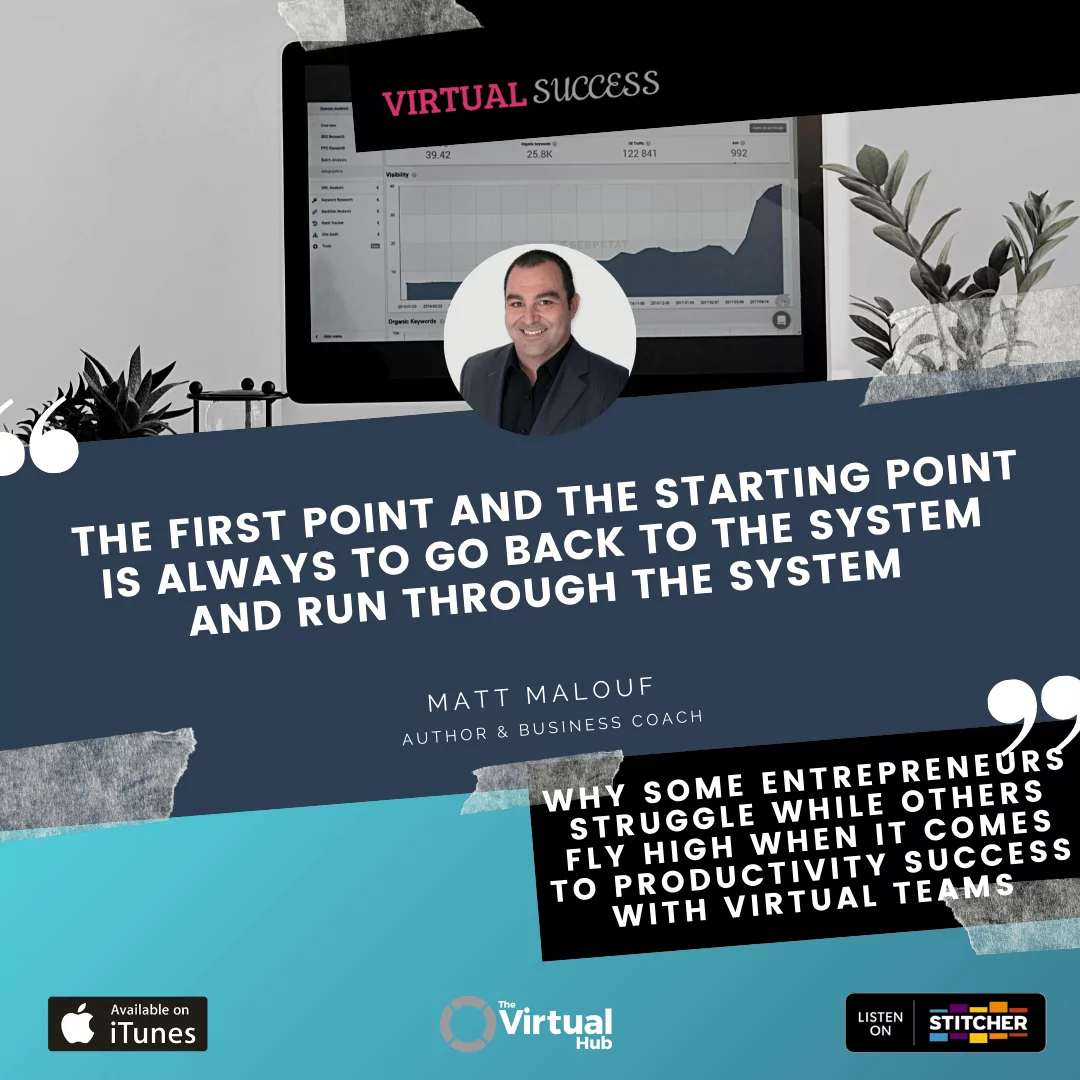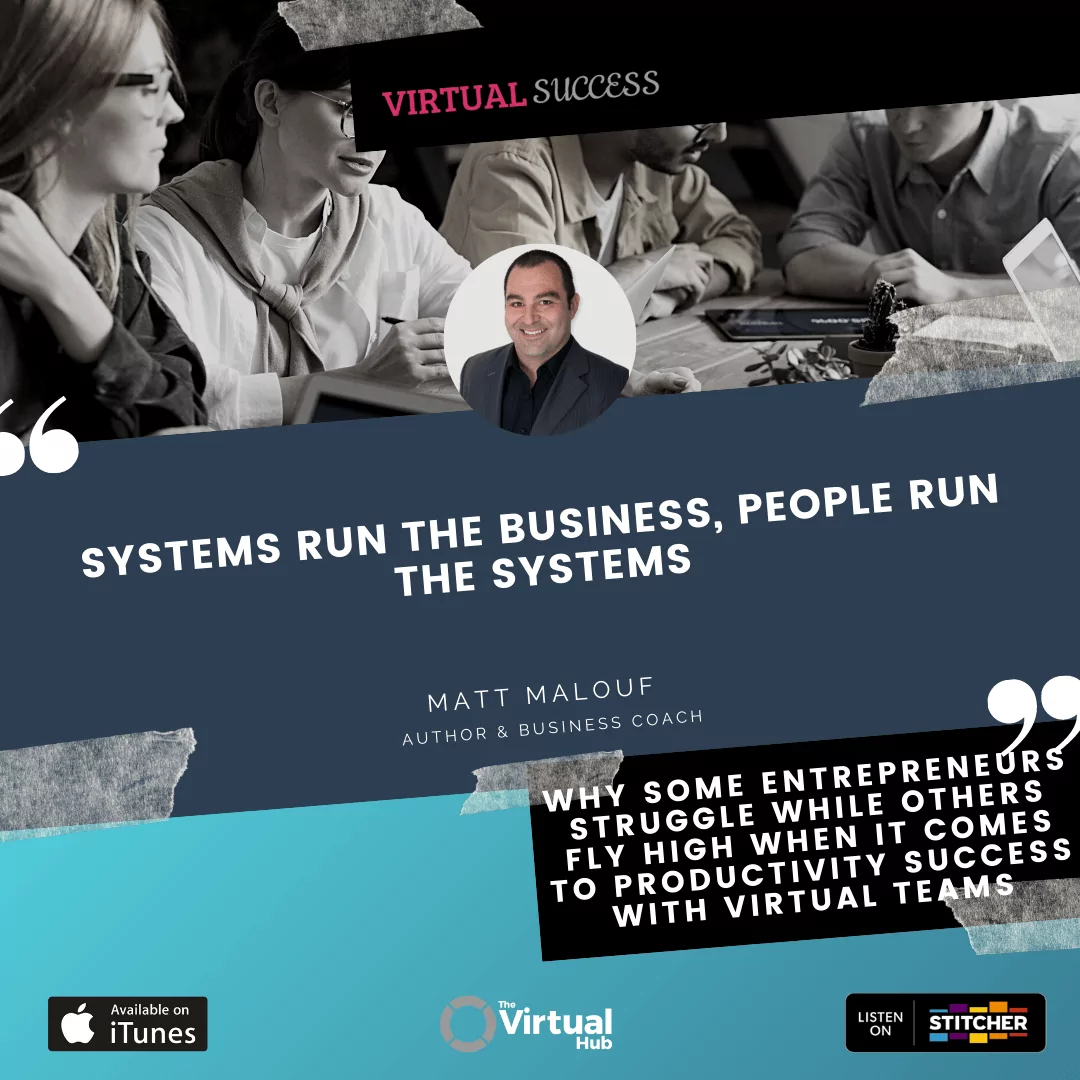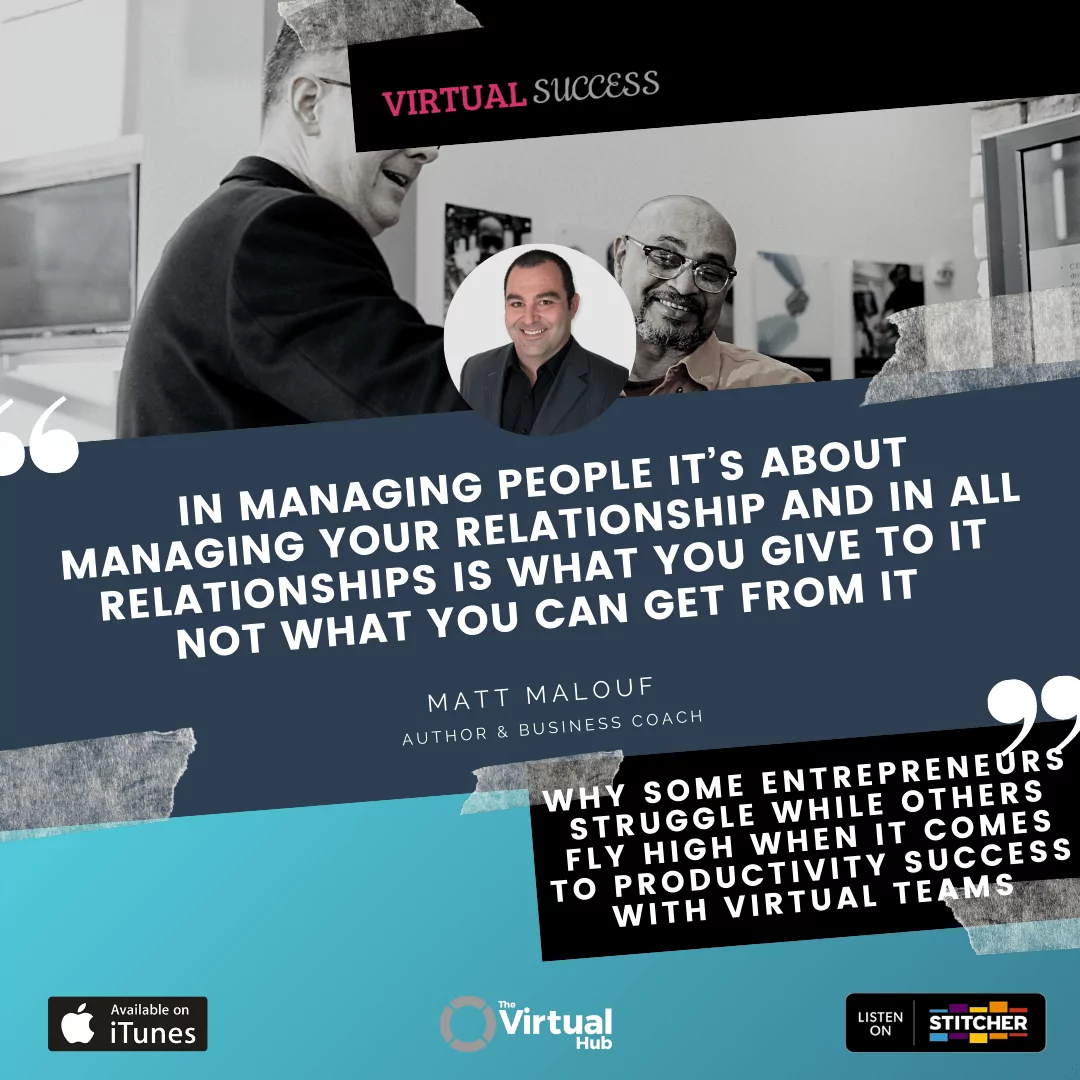Why Some Entrepreneurs Struggle While Others Fly High When It Comes To Productivity Success With Virtual Teams
Want the transcript? Download it here.
In this episode, we tackle the big issue of why some entrepreneurs really struggle when it comes to getting productivity success with virtual teams.
Having a great virtual team is like the holy grail when it comes to entrepreneurial freedom but sadly many struggle to really make it work.
There are a few key things that typically trip most people up and in today’s show we give you someactionable tips to avoid the most common pitfalls.
- Why having the right systems (that actually work) is the key starting point for success.
- How to make sure your team have the right thought process as you when they are implementing your systems and processes.
- Why many entrepreneurs unwittingly set their teams up to fail … then blame them!
- How to foster true win/ win relationships with your virtual team & get explosive success.
Let us know what your key takeout has been from this episode and join the continuing conversation over in the Virtual Success Facebook Group.
In this episode:
01:21 – The scenario
04:39 – Common pitfalls when onboarding your VA
06:10 – Check your systems and processes
07:42 – Don’t overcomplicate things
09:11 – Regularly review your systems
11:00 – “People run the systems…”
12:45 – Have a strong vision for your business
13:32 – Expectations misalignment
15:07 – It starts with you, the owner
16:14 – Managing your relationships
16:51 – Viewing your virtual staff as an asset
19:26 – Am I setting my team up to fail?
20:22 – Fostering strong communication
22:09 – Let’s recap
24:42 – Wrapping things up
Matt: Hey welcome to the show this week! I’m joined by my co-host Barbara Turley, hey Barb!
Barbara: Hey Matt! How’s it going? Good week?
Matt: I’m having a great week and yourself?
Barbara: Ah yes pretty good! Busy as always but you know going well.
Matt: Excellent, excellent! Barbara I’m really, really looking forward to today’s episode. It’s really interesting, in the conversation we’re having, just preparing about some of the challenges that you’ve been witnessing with virtual teams this week and I’m really excited about the challenge you’re going to share with everyone today and how you are going to unpack that and help everyone learn how to solve this. Do you want give everyone an insight into what’s been happening?
The scenario
Barbara: Sure, yes! Well I had a really interesting situation happen this week where, you know, we often send feedback forms out to our clients about how their VAs are doing in Virtual Angel Hub, where as you know we recruit and train Vas. And I call it ‘compare the pair’ because we’ve had this interesting one come back where we have the same VA working on two different client accounts, part time on both accounts. Both businesses are similar business models so they’re not that dissimilar, they both do similar task lists and one arguably is more complex than the other. But the business that is a bit complex, the feedback about the VA was she is fantastic, I don’t know what I would do without her, her attention to detail has been amazing, her initiative, you know, glowing, glowing report! The other business has come back with a list of complaints, says the attention to detail is low, basically not happy, not wholly happy with this VA, we want to have a whole discussion about it. So I find this very interesting because how can the same VA with the same experience and the same attitude have two dramatically different situations occur with different clients. So it’s been a tricky one for me to unpack.
Matt: Absolutely! So just to reiterate, we have very similar businesses, similar task lists that the VA has to perform for the both businesses. One raves about them and the other is considering what, dropping them?
Barbara: Yeah I would say not dropping them yet but I know from the feel that we’re heading in that direction.
Matt: So let’s call it, frustrated and unhappy!
Barbara: So frustrated, yeah! And unhappy.
Matt: So it’s really interesting isn’t it? Because again, just in the analysis piece here, you know you’ve got what’s the common denominator, well the common denominator is the virtual assistant. The environment is very similar and so where do the differences lie? The differences lie in the managers and leaders really, when you really start to look at this.
Barbara: Yeah absolutely, yeah! You know of course the natural tendency in this situation I’ve noticed with clients of ours, I mean this is natural, is the person who’s not having such a great experience, the first thing they want to do is they want to get rid of them, they immediately say, ‘well clearly the VA doesn’t really know what she’s doing and I just need someone else’. And we’ve had this situation happen a couple of times you know, and sometimes, and that particular client will end up going through strings of VAs so this is an add-on to this where they’ll end up having the similar problem happening, recurring with different VAs that go in.
Matt: Interesting and I think the thing to highlight here is there’s a common denominator in that scenario that you just posed, which is, it’s the business owner.
Barbara: Yes, so the common denominator in the first scenario is the same VA, different outcome and in the second sort of add-on, it’s same business owners, same client, different VAs.
Common pitfalls when onboarding your VA
Matt: And you know Barbara I think in my work as a business coach and I literally coach a thousands of businesses every year, I see this all the time. I see this both with virtual teams as well as, you know, people that you employ directly in your offices and the like, physical teams where business owners or managers are getting frustrated and so they’re hiring people and people aren’t doing what they desire, work the way they want, in the right manner. They get rid of that person, bring in another, same thing happens. They do it again and the interesting thing is, they never stop to look and ask themselves, ‘well, what’s the challenge here?’, ‘where’s this breaking down over and over again?’. And so what they end up doing is playing out insanity, they keep doing the same thing over and over again and expecting a different result.
Barbara: And getting more frustrated along the way because obviously doing that you’re developing a vicious cycle of hiring, firing, hiring, firing, retraining – it’s very exhausting on any business owner.
Matt: And costly! Extremely costly! So, what I’d love to do for our listeners right now is probably give a little bit of a checklist or methodology that you can go through in unpacking and solving this kind of problem, what do you think Barb?
Barbara: That sounds great! I’m really keen to delve into this with you because you’ve done this with so many businesses, so that’s why I’m excited about today’s show because I’ll definitely learn a lot from this.
Check your systems and processes
Matt: Fantastic! So the first thing that I always recommend in this scenario, let’s just go with scenario one. You’ve got one VA serving two people doing similar tasks but getting different results. For me if your virtual assistant or anyone in your team is not getting the result that you desire, the first thing I always go back to is the system that they’re implementing. We need to remember that the systems are what drive our business and our people drive the systems. So in our own businesses and together with the companies that we coach, that’s the starting point. Let’s go back to the system. Is there a system flaw? Is there a chink in the chain? It’s often new system and processes that are being applied, something’s often been forgotten, we haven’t documented something, we haven’t trained something in the right way. So, the first point and the starting point is always to go back to the system and run through the system and ideally what you would do is you would have your virtual team member run through from their model of the world, the system that they’re implementing.
Barbara: Yeah!
Matt: So that you can understand, are they doing it the way that it has been documented? Where is it falling down?
Don’t overcomplicate things
Barbara: It’s funny because, one of the things we do with clients when they come in to Virtual Angel Hub is we actually we talk a lot about their processes and something I’ve been out talking about a lot recently is saying to people, ‘sometimes a mistake is actually a gift because it shows you where there’s a hole in the process’, assuming nothing else is the problem. Often I see business owners and I know you would see this as well, they think they have a process but when you actually go to do it or you watch the person, maybe the VA or your staff member trying to do it, it’s such a complicated process that could be simplified and where there are so many areas where mistakes can happen. I call it the margin for errors. You know, the margin for error in their process is so large that a lot of people are going to end up making mistakes. So this problem of inefficient processes, how do you deal with that one? Or complex processes? I guess what I’m saying is, overly complicated processes.
Matt: I think, look, at the end of the day you need to make things as simple as possible. I think a big mistake I see with processes is people document, you need to do a, b and c when they’re teaching the system, though, they’re not teaching people how to think through what could go wrong or the questions that often you’re asking yourself unconsciously in your head as you implement the system.
Barbara: That’s very valuable! Yeah, yes that’s a really big problem that we see a lot.
Regularly review your systems
Matt: Yeah, so I don’t know that it’s necessarily the complexity of the system, it often comes down to a training issue that you haven’t taught somebody how to think while they’re implementing the system. There’s only so much you can document or get through a video or an audio. It’s teaching people how you think. I think the second part of that is to make sure that you’re reviewing systems regularly and becoming efficient at what you do; you know what I mean? I found a lot of system breakdown occurs because people are trying to cut corners to save time rather than sitting there and working the system and going, how can we become more efficient? As I said, they simply try and cut things out without testing it and hence it leads to some mistakes. So I think the reality is that some systems are simpler than others. There are at times going to be complex parts to anyone’s business and its just addressing those and breaking things down to lowest common denominator, keeping it as simple as possible in order for people to succeed. And just to add to that last bit – it’s setting people up to win, it’s setting people up to succeed.
Barbara: So what about, so number one is check the system and really know how that’s performing. So let’s say that you feel like, you know, the system works well it’s very, you know, its detailed enough etc. Let’s say that’s not the issue, what would be the next thing that we would look at?
“People run the systems…”
Matt: The next thing I would look at is I would try and understand from the person’s perspective, the team members’ perspective where they feel it’s breaking down. So as we mentioned before, systems run the business, people run the systems. So is it a people issue? Is it that my virtual team member is distracted? Have they got the right work environment? Am I communicating in a way that is effective for them? Am I training them the right way? Do they actually have the level of competency that I expect? Do they actually understand what I expect and how I want things done? So I’m asking all these questions around the people side of this so, if the system gets a big tick then we’ll look at the people and I think, are they the right person? Do they have the right skillset? Have I trained them enough? And I guess, are they aligned with me and my business?
Barbara: Yeah, I mean that can be a tricky one too! Because as you know, staff come in to jobs for various different reasons and often I will say to clients, they’re never going to love your business as much as you do, of course. They will, but it’s your baby really and sometimes I think business owners sort of have an expectation on their staff to, I guess, love and adore it all as much as they do. And well that’s nice in theory and I think in reality its – they never love it as much as you do of course. It’s a different relationship with the business.
Have a strong vision for your business
Matt: Absolutely, absolutely! I think this is where, it was going to be my fourth point but I’ll make it now – I think this is where having a strong set of values and having a vision for the company helps people buy into something bigger.
Barbara: Yeah, that’s a good point!
Matt: So I think often with these breakdowns with people, and again coming back to the original scenario – person A loves the VA, person B it’s not working for them – there’s a mismatch, the mismatch comes because it could be a values misalignment or a culture misalignment within the business, or often there’s an expectations misalignment.
Expectations misalignment
Barbara: I think that’s a huge one actually, I think expectations misalignment is a big one.
Matt: And this often comes about because the core values and the expectations have never been documented and the people within the company have never been educated around this. So there’s this assumption that, well they’re just going to do it the way that I expect them to do it, but you’ve never clearly defined how you expect them to do it. And I think this is very, it’s a very personal thing. I’ve coached companies before where you’ve got two business owners sharing a virtual assistant and the two owners have very different philosophies. You’ve got owner number one that needs to be updated constantly or effectively micromanages, but you’ve got owner number two who is more deadline driven and doesn’t mind how the virtual assistant gets from point A to point B as long as they get there by the due date. There’s always going to be challenges there because of the misalignment, that person will probably only ever meet the expectations of one of those owners. And so the question you’ve got to ask yourself is, number one – am I clear on what I expect? and, number two – is my virtual team member clear then on what I expect? And so it starts with you!
Barbara: Yeah rather than making assumptions.
Matt: That’s right!
Barbara: There are a lot of assumptions made in all these situations I think!
It starts with you, the owner
Matt: The reality is Barb, that with a lot of these challenges, both with virtual teams and local teams, it often comes back to the owner, manager or leader and it’s often because they’re so focused on so many different things, so many different areas of the business, ‘I’ve got to get to breakeven’, ‘I’ve got to keep the cash flow happening’, ‘I’ve got to market!’, ‘I’ve got to sell!’, ‘I’ve got to deliver!’. There’s so many things that this piece, which you know Steven Cavi would call ‘important but not urgent’ task of defining your core values and defining the expectations that you have gets forgotten and then we wonder why we have these people challenges.
Barbara: Yeah that’s not working! And interestingly, I love that you touched on this whole leadership piece because I want to know what your thoughts are on how important is, I mean I know it’s important, but how much can the relationship between a staff member – be they a virtual or not – and a leader, affect the sort of outcomes that you’re getting?
Managing your relationships
Matt: Well at the end of the day, people are people, aren’t they? So relationship, I think, is vitally important. We need to get clear that, you know, in managing people it’s about managing your relationship and in all relationships is what you give to it not what you can get from it. That’s why I think a lot of business relationships, employer–employee relationships fall down is because the employer is focused on what they can get from the employee as opposed to how can we work together in a win-win scenario to achieve what it is we’re setting out to achieve.
Viewing your virtual staff as an asset
Barbara: I love that because there’s something I’m really noticing out there is the people I’m seeing that are doing really well with their virtual staff and I know it’s the same in regular offices as well. When the business owner truly sees this person as an asset that they can use and grow and you know an asset to be grown for the betterment of their company, they do really, really well! But naturally when we’re in business and, as you say, cash flow – one of the greatest you know headaches that any businesses goes through – and sometimes when cash flow is tight or things are a bit rough, even if you don’t realize it internally see your staff or teams as a real cost and a drain on you and I think that’s when relationships start to break down because you may not realize the it changes your tone, it changes how you communicate with them and they feel it and the whole relationship starts to kind of breakdown. I have seen that happen a little bit as well and I wonder what you think about that?
Matt: Absolutely! I think it’s all about personal management, isn’t it Barb? It’s understandable when you’ve got cash flow challenges which, by the way again in my experience in coaching many businesses, whether you’re a startup or, you know, I’ve seen companies turning over $20 million plus, there’s still cash flow challenges from time to time and so managing cash flow is one of the most critical parts of any business. But the reality is, you’re right, it’s about cash is tight, I want to get the most out of this person and I want to make sure I’m maximizing my return, why aren’t they getting things when I need them? And there’s all this pressure on you that you then project on to them and often they don’t understand why. They’re just there doing their thing and wondering ‘What have I done wrong? What’s going on today?’.
Barbara: That starts to induce fear as well, fear and uncertainty in the staff member and I’ve noticed that once people with the VAs that we have along the way, I’ve noticed that once they slip a bit, they think they’re not good enough you know I’m dealing with Filipinos and that actually culture over there I mean this is everywhere but constantly with them I’ve noticed that they start to feel that they’re not good enough, mistakes start to escalate because they start to really fear for their job, they fear for themselves and mistakes can actually escalates because of that.
Am I setting my team up to fail?
Matt: Absolutely! I think anyone put under that kind of pressure is going to make mistakes. So it’s like what we were talking about earlier, setting people up to win. But you now we’re talking on this topic of communication, that’s where it comes down to. It’s another area where this needs to be addressed in order to solve this problem is the communication, ‘Am I communicating clearly?’, ‘Am I giving clear, concise instructions that the other person, my virtual team member, understands?’. You know, its remembering that for many of these virtual team members, English is a second language for them.
So one of the little techniques that I use regularly is I get my team to repeat back the tasks so that I hear it, I’ll get them to either type it back to me or say it back to me so I can hear it and refine it right at the front end.
Fostering strong communication
Barbara: That’s great! Remember we did a whole show on this, obviously communication, I mean, it’s so key to remember to invest time with your communication with your virtual team member.
Matt: Absolutely! And I think with the communication side, one habit that I have gotten into with my teams is, the cycle of our business is that once a quarter we have a road show and a whole heap of events and the reality is there’s a lot of pressure, there’s a lot of stress. You know, we’re traveling from city to city and I think we hosted 6 to 7 events in the space of 5 days, so it’s full on. And I always preface to the team, I say, ‘Guys you know obviously we’re riding the big wave now, you know it’s kind of like the calm before the storm when we’re riding the wave, just keep in mind that I’m going to probably be short and I’m going to just be giving you things in bullet points. Please don’t take offense to it, I’m going to rushing it, I’m going to be on stage, off stage, a whole heap of stuff.’ They understand, so they don’t take offence to it. So if I give short sharp responses or instructions they understand because Matt’s got a lot going on at the moment.
Barbara: Yeah, not that I’m not good enough and the relationship has changed or I’ve done something wrong because that’s what starts happening particularly in written communication. You know short sharp written stuff; I find can sound sharper than the person meant to. So just to recap then because this is such a fascinating area you know and often I think people are getting rid of very good virtual teams or virtual staff too quickly is what I’m seeing. Sometimes we need to get rid of the person but sometimes it’s actually not the person.
Let’s recap
So let’s just recap the points you made there so, first step is – look at the systems, system drives the business, people drive the systems, so system’s first. And after that it’s important to look at the person, but not necessarily I would say don’t immediately look at the flaws of the person, let’s look at how that person is implementing the system, how they have understood the training etc. before we move on to ‘Is this just a bad employee?’ for example. And then the relationship and the communication, the relationship and making sure that is, I guess, a positive reinforcing type of relationship rather than an underlying negativity that may be there that can affect communication. And then I love your point about the making sure that there’s no mismatch with values and expectations. So that both people understand what success looks like and what we’re striving for.
Matt: And I think all of these four points Barb need to form part of your recruitment process in recruiting your virtual teams and they also need to form part of your performance review criteria in assessing them on their performance against these criteria as well. So it shouldn’t only be a checklist that’s used when there’s a problem.
Barbara: Yeah can be ongoing – this actually formulates the entire backbone of your virtual team by the sounds of it, from recruitment, right through to ongoing management.
Matt: Absolutely, absolutely!
Barbara: I’ll definitely be taking that point! It’s very valuable to me.
Matt: So if we just bring this all back to where we started with this in the scenario, where you’ve got a virtual team member serving client A, who loves them and is getting a great result and client B, who is having some challenges. I’m sure if we went through each of these four points very quickly, client B would understand and start to highlight the gaps either in the client or in the systems within their business.
Wrapping things up
Barbara: Yes, I mean from my own knowledge of some of the issues I’ve seen, a lot of it comes down to having no systems and processes which we talked about many times and we will many times again on this podcast, is that’s just a road to disaster if you trying to scale a business or you’re trying to build something that is a true business. And I think the other one I see a lot is communication, we did a whole show on this because it’s so important. Communication style and the relationship, even the unconscious relationship is very, very important to look at and to look at yourself as well and how you are viewing your staff. If you’re viewing from an internal place of maybe a little bit of resentment, that sort of thing, the cost vs. asset thing that can really come back and bite people badly. Sometimes they don’t know they’re doing it.
Matt: Absolutely, absolutely! Well Barbara, I think that was great. I mean I hope that’s given you some insights that you can take back and work through some of the challenges.
Barbara: Absolutely! I’ve been furiously write notes Matt, this has been a great episode for me I have to say and I know that given I have got so much out of it, I can imagine people listening will really have an eye opener, a few eye opening realizations having had this process laid out. So thanks for that!
Matt: You’re welcome! Thank you Barb and have a fantastic week and until next week’s episode.
Barbara: Yep! See you then.
Matt: See you then!
The Hosts
Matt Malouf
Matt Malouf is a passionate business coach, speaker, author and entrepreneur on a mission to help entrepreneurs around the world break the shackles of mediocrity and reach new levels of personal and business success.
Barbara Turley
Barbara Turley is the Founder & CEO of The Virtual Hub, a company that specializes in recruiting, training and managing superstar ‘Virtual Assistants’ in the social media, digital marketing and systems automation space.





